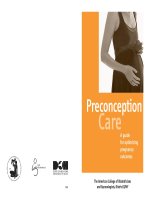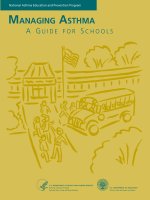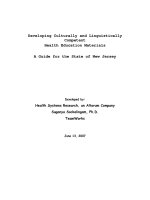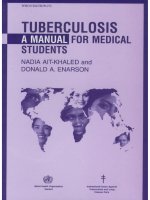A Diet for Healthy Bones
Bạn đang xem bản rút gọn của tài liệu. Xem và tải ngay bản đầy đủ của tài liệu tại đây (2.22 MB, 59 trang )
A Diet for Healthy Bones
University of California, Berkeley • Center for Weight & Health
/>This project has been funded with federal funds from the U.S. Department of Agriculture, under the Food Stamp Nutrition Education Program.
The contents of this training session or of these educational materials do not necessarily reect the view or policies of the U.S. Department of
Agriculture, nor does mention of trade names, commercial products, or organizations imply endorsement by the U.S. government. USDA is an
equal opportunity employer.
Lesson
1
Lesson
1
A Diet for Healthy Bones
Goal
• Increase knowledge of osteoporosis and the importance of diet for healthy bones.
Key Messages
• Osteoporosis is a common condition that can be prevented.
• Eating a balanced diet that includes adequate amounts of foods rich in calcium and
vitamin D will help prevent or delay osteoporosis.
Summary
This lesson will describe osteoporosis and discuss how to maintain healthy bones through all
stages of life. Participants will learn about the risk factors for osteoporosis, as well as ways to
improve bone health. Emphasis is on including calcium and vitamin D-rich foods as part of a
balanced diet.
Learning Objectives
1. Identify the risk factors for osteoporosis.
2. Identify foods that promote bone health.
By the end of the lesson, participants will be able to:
• Define osteoporosis.
• List the risk factors for osteoporosis.
• Learn how osteoporosis is diagnosed.
• Identify calcium needs for each age group.
• Identify calcium-rich foods and sources of vitamin D.
• Identify calcium-rich foods that people with lactose intolerance can eat.
• Explain when a calcium supplement may be recommended.
Lesson 1: Page 1
Learning Activities
1. Getting started
2. Pretest (optional)
3. Calcium screener (optional)
4. Learning about osteoporosis
5. Osteoporosis: risks and prevention
6. Calcium and vitamin D-rich foods
7. Post test (optional)
Materials
• Styrofoam (9 x 12 inch sheet can be purchased at a fabric store or craft store, to be cut into
smaller pieces)
• Bone model (provided)
• “Picture Your Bones” packet and/or powerpoint presentation (English, Spanish, Vietnamese)
• “Bone Health Q & A” discussion cards (English, Spanish, Vietnamese)
• “Yogurt with Fresh Fruit Recipe” ingredients for food demonstration
Handouts (English, Spanish and Vietnamese)
• Lesson 1 Pre and post test (optional)
• “Calcium Screener” (optional)
• “A Diet for Healthy Bones” with goal setting pamphlet
• “Yogurt with Fresh Fruit Recipe” recipe cards
Lesson 1: Page 2
Suggested time: 60 minutes
(5 minutes)
(5 minutes)
(5 minutes)
(10 minutes)
(10 minutes)
(20 minutes)
(5 minutes)
1. Getting Started
(5 minutes)
• Greet the participants.
• Complete FSNEP forms as required.
• The theme of this lesson is bones are a complex living tissue.
2. Pretest
(optional) (5 minutes)
Handout
• Pretest
• Pass out and collect pretest. The pretest questions can be used as openers for
discussion.
3. Calcium Screener
(optional) (5 minutes)
Handout
• “Calcium Screener” (English, Spanish and Vietnamese)
The calcium screener is a quick and easy way to determine who may not be getting
enough calcium from their diet. There are many high calcium foods that are not on this
screener.
The screeners are ethnic-specific, and are in English, Spanish and Vietnamese
languages. They each have different foods to better represent the calcium intake of the
diets of African Americans, Latinos and Vietnamese.
Learning Activity
• Pass out the ethnic-appropriate screener and have the participants check the boxes
under the pictures of foods they eat one or more times each week.
• Have participants follow the instructions in the last panel.
• Discuss the results with the class.
• Collect the screeners.
Lesson 1: Page 3
Frequently Asked Questions
Q: What is a calcium screener?
A: A calcium screener helps identify who may have a very low calcium diet. It
doesn’t tell us exactly whether someone is getting enough calcium nor does it
tell us specifically how much calcium is in our diet. To get a complete analysis
of your dietary intake of calcium, you may need a more extensive review
of your diet.
Q: Why can’t we keep the calcium screener?
A: The calcium screener was not designed as an educational tool. We have
developed other materials that will provide you with information on calcium-
rich foods, such as the
“A Diet for Healthy Bones” pamphlet.
4. Learning about Osteoporosis
(10 minutes)
Materials
• Picture Your Bones Packet and/or Picture Your Bones powerpoint presentation
Osteoporosis is often called the “silent disease” because a person can have it and not
know. You usually won’t experience any pain, signs or symptoms during the early
stages. Then one day, you break a bone while doing a routine task, or break a wrist
or a hip after a fall. Many people don’t know they have osteoporosis until a fracture
happens.
Getting enough calcium from your diet and doing weight-bearing exercises
help
make bones healthy and work to prevent or slow down osteoporosis. Weight bearing
exercise is about being on your feet. Walking is a good example of a weight bearing
exercise.
When you’re young, bone grows larger, stronger and denser as the rest of the body is
developing. As we age, we begin to lose bone. One of the symptoms of osteoporosis
is a loss of height. One could lose as much as 2 to 4 inches of height in later life due to
bone loss. It is possible to slow bone loss through proper diet and exercise.
Lesson 1: Page 4
Calcium is a mineral essential for strong bones. The body does not make calcium, so we
must get it from food. Children and teenagers need to eat a lot of calcium-rich foods
because their bodies and bones are actively growing. Adults need calcium to maintain
their bones and to slow down bone loss. If you cannot get enough calcium from foods,
talk to your doctor or health professional about taking calcium supplements.
Bone is complex living tissue. The body is constantly building new bone tissue and
breaking down old bone. Today we will learn how diet and exercise affect bone growth
and what we can do to keep our bones healthy.
4.1 Learning Activity
Osteoporosis means “porous bones”. Porous bones become weak and easily break.
With a loss of bone tissue, bones that were once dense and strong may not be able to
withstand the stress of even normal activity, such as bending over or twisting.
• Use the bone model to show the difference between a normal and an osteoporotic
bone.
• Use the styrofoam to show how easily a porous bone can break by snapping the
styrofoam in half.
• Show “Picture Your Bones” picture (slide 1).
• Share the information on the picture (slide).
Did You Know?
• One out of two women will have osteoporosis in her lifetime.
• Two out of every ten men will develop osteoporosis.
4.2 Learning Activity
There is no cure for osteoporosis. However, you can slow down bone loss by
increasing your daily calcium and vitamin D intake, and doing 30 minutes of physical
activity each day.
• Show
“Picture Your Bones” picture (slide 2).
• Share the information on the picture (slide).
Lesson 1: Page 5
Discussion Questions
• “Does anyone here know someone with osteoporosis?”
• “How is his or her life affected by osteoporosis?”
• “How common is osteoporosis?”
4.3 Learning Activity
Bone fractures impact the quality of life. Promoting bone health early in life can
prevent fractures later in life and help older people live more independent lives.
Having weak or porous bones can increase the risk of fracturing or breaking bones.
Older people with osteoporosis are especially at risk for breaking bones in the hip,
spine or wrist.
Fractures are painful, serious health conditions and can:
• be disfiguring
• be disabling
• limit quality of life by severely reducing the ability to lead an active life
• Show “Picture Your Bones” picture (slide 3).
• Share the information on the picture (slide).
Discussion Questions
• “Has any elderly person you know fallen and broken or fractured a bone?”
• “How did that affect his or her life?”
4.4 Learning Activity
Age and the effects of osteoporosis can cause a curvature of the spine called kyphosis.
• Show “Picture Your Bones” picture (slide 4).
• Share the information on the picture (slide).
Lesson 1: Page 6
Discussion Question
• “Have you ever noticed an elderly relative or friend who became shorter as she/he
aged?”
4.5 Learning Activity
A common way to diagnose osteoporosis is to have a DXA scan (pronounced “dexa”)
that tells us how strong your bones are. The DXA scan:
• measures how dense bones are
• measures the bones in the hip, spine, wrist, forearm and other areas
• is painless
• is safe
• Show
“Picture Your Bones” picture (slide 5).
• Share the information on the picture (slide).
Discussion Questions
• “Has anyone here had a DXA scan?”
• “What did it feel like?”
Frequently Asked Questions
Q: I think I have strong bones. I eat pretty well and exercise too. Do I really need
to have a DXA scan to know if I have osteoporosis?
A: For now, it is the best way to tell if you have osteoporosis.
Q: At what age should a person get a DXA scan?
A: A DXA scan is generally recommended for women after menopause, or
sometimes earlier. It may also be recommended if repeat bone fractures have
occurred or a person has lost more than two inches of height.
Lesson 1: Page 7
5. Osteoporosis: Risks And Prevention
(10 minutes)
Handout
• “A Diet for Healthy Bones”
Osteoporosis can affect everyone as we get older. Women are more likely than men
to get osteoporosis because of their different hormonal makeup. White and Asian
women are at highest risk for developing osteoporosis; however, African American and
Hispanic women, and men can still get osteoporosis.
5.1 Learning Activity
• Pass out “A Diet for Healthy Bones” pamphlet for participants to refer to during the
discussion.
Discussion Questions
• “Do any of you think you might be at risk for osteoporosis?”
Here are factors that increase a person’s risk for osteoporosis:
• Not eating enough calcium-rich foods
• Not getting enough vitamin D
• Not doing enough weight-bearing exercise
• Hormonal changes with menopause or stopped menstruation
• Having had a hysterectomy or ovaries removed
• Family history
• Current smoking
• Drinking too much alcohol
• “What can I do to prevent osteoporosis?”
Building healthy bones by getting enough calcium and exercising is important at
every stage of life. Children and teenagers need more calcium because their bodies
and bones are actively growing.
Lesson 1: Page 8
Adults need calcium to maintain their bones and help slow bone loss as they get older.
It is very important for a person who has been diagnosed with osteoporosis to get
enough calcium to slow further bone loss.
The four steps to osteoporosis prevention
1
• Meeting your daily value of calcium and vitamin D
• Getting 30 minutes of weight-bearing exercise daily
• Avoiding smoking and drinking alcohol only in moderation
• Talking to your doctor or health professional about bone health and bone mineral
density tests
Frequently Asked Questions
Q: What is a weight-bearing exercise?
A: Weight-bearing exercise is any exercise where your feet and legs carry your own
weight. Examples are walking, jogging and dancing.
Q: What does drinking alcohol “in moderation” mean?
A: Studies show that drinking too much alcohol can hasten bone loss and reduce the
body’s ability to absorb calcium. If you drink alcohol, limit intake to no more than
one ounce a day for women and two ounces a day for men. An ounce equivalent
would be a small glass (3 to 4 ounces) of wine for a woman; a two ounce equivalent
would be two beers for a man.
Q: At what age do I have to start being concerned about osteoporosis?
A: At all ages. Building strong bones during childhood and adolescence through
exercise and a healthy diet, adequate in calcium, can be the best defense against
developing osteoporosis. Osteoporosis is largely preventable for most people.
Although osteoporosis is generally diagnosed during later life, we should be aware
of the importance of taking steps toward developing strong bones during early life.
1
National Osteoporosis Foundation. Available at: />Lesson 1: Page 9
Q: Where can I go for more information on osteoporosis?
A: Your health professional can provide you with additional information on
osteoporosis. If you have access to the internet, the National Osteoporosis
Foundation website has a lot of information on osteoporosis. Their website can be
found at: .
6. Calcium and Vitamin D-Rich Foods
(20 minutes)
Materials
• “Bone Health Q &A” discussion cards (optional)
• “Yogurt with Fruit Recipe” ingredients for food demonstration and tasting (optional)
Handouts
• “A Diet for Healthy Bones”
• “Yogurt with Fruit Recipe” recipe cards
6.1 Learning Activity
What foods have calcium?
• Discuss the list of calcium content in foods from the “How much calcium is in foods?”
table in the “A Diet for Healthy Bones” pamphlet.
• Engage class in a discussion using the “Bone Health Q & A” cards.
Lesson 1: Page 10
Food
2
Serving size ~Calcium in milligrams
Milk, fat free, 1%, 2%, whole, lactose free 1 cup 300 mg
Orange juice, calcium-fortified 1 cup 350 mg
Milk, nonfat dried 1/4 cup 375 mg
Yogurt 1 cup 370 mg
Soymilk, calcium-fortified 1 cup 365 mg
Sardines, canned, with bones 3 oz. 325 mg
Cheese 1 oz. 205 mg
Salmon, canned, with bones 3 oz. 165 mg
Almonds, raw 2 oz. 150 mg
Beans, black, cooked 1 cup 120 mg
Nopales, cooked 1/2 cup 120 mg
Cereal, calcium-fortified 1 cup 100 mg
Greens, turnip, cooked 1/2 cup 100 mg
Kale, cooked 1/2 cup 45 mg
Beans, red, cooked 1 cup 90 mg
Okra, cooked 1/2 cup 60 mg
Broccoli, cooked 1/2 cup 35 mg
Greens, collard, cooked 1/2 cup 130 mg
Orange, fresh 1 medium 50 mg
Sweet Potato, baked 1 medium 40 mg
Calcium is found in many foods, but some foods have more calcium than others. Dairy
foods such as milk, yogurt and cheese are good sources of calcium. It is important to
have a balanced diet. If for some reason you avoid dairy foods, there are other foods
that have calcium. Some of these are listed below.
2
USDA National Nutrient Database />Lesson 1: Page 11
Ethnic-Specific Tips
If most people in your class are from a certain ethnic group, you may want to include
some of the following tips for increasing calcium intake:
Vietnamese
When making soup with chicken or other animal bones, add one teaspoon of vinegar
to the soup. This will enable the calcium to cook out of the bones and will make a
calcium-rich soup base. Also when making curry sauce, use reduced-fat or low fat milk
instead of coconut milk.
African Americans
If you like eating sardines, remember that they are a good source of calcium. However,
be careful not too eat too much. Sardines are high in salt. If packed in oil, sardines are
also high in fat. Try sardines packed in tomato sauce for a lower-fat variety with the
same amount of calcium.
Latinos
Pinto beans and cheese are excellent sources of calcium, along with milk. Whole milk,
reduced-fat, low fat and nonfat milk all have the same amount of calcium in them. Try
using low fat or nonfat milk as they are low in fat but still high in calcium.
Discussion Questions
• “Do you eat any of these high calcium foods?”
• “If yes, which ones?”
• “If no, which ones might you try to add to your diet?”
Lesson 1: Page 12
6.2 Learning Activity
How much calcium do I need every day?
Age
3
Daily calcium needs in
milligrams
Daily cups of milk
51 years and older 1,200 mg 4 cups
19-50 years 1,000 mg 3-4 cups
9-18 years 1,300 mg 4+ cups
4-8 years 800 mg 3 cups
1-3 years 500 mg 2 cups
7 months-1 year 270 mg 1 cup
Birth-6 months 210 mg Breast milk/formula*
Discuss the “How much calcium do I need every day”? in the “A Diet for Healthy Bones”
pamphlet.
You can think of the calcium needs of your bones as a bank. Much like depositing
money into a bank, you deposit calcium into your body, which helps make your bones
stronger. Your body withdraws calcium to help with everyday functions of the body.
You make deposits and withdrawals every day of your life. From childhood until
about age 30, you are making more deposits than withdrawals, and bones continue
to grow and become denser. After menopause, women experience bone loss and
the “withdrawals” become much greater than the deposits. Therefore, you should be
“saving” calcium for your future by eating more calcium-rich foods in your younger
years.
Nonfat and low fat dairy foods are healthy choices because they have the same
amount of calcium as whole milk, but less fat. Every cup of milk has about 300
milligrams of calcium.
Encourage your children to drink milk or water instead of soda. Children have small
stomaches and fill up quickly. If they drink soda and other sweet drinks, they won’t
have room for milk and the healthy foods they need to grow. Eating a balanced diet
with a variety of foods, emphasizing water and limiting sodas is the best way to ensure
children will build healthy, strong bones.
* American Academy of Pediatrics recommends exclusive breastfeeding for approximately the first 6 months after
birth. It is recommended that breastfeeding continue for at least 12 months. Infants weaned before 12 months of
age should not receive cow’s milk but should receive iron-fortified infant formula.
3
/>Lesson 1: Page 13
• For children under one year old, breastfeed or use a formula with iron, unless your
doctor tells you otherwise. Infants have difficulty digesting the protein in cow’s
milk. Breastmilk has all of the nutrients required by babies; iron-fortified formula is
recommended when breastmilk is not available. For children less than one year old,
cow’s milk does not have all the necessary nutrients.
• For children, one to two years old who are no longer breast feeding, use whole milk.
They need the fat in whole milk for proper brain development.
• For children over two years old, use low fat or fat free milk.
• Women who are pregnant or breastfeeding need the same amount of calcium as
other women their age.
Frequently Asked Questions
Q. Why do children and teenagers need more calcium?
A. Because they are growing, they need more calcium to help build strong bones. As
you get older, your bones do not absorb calcium as well and your body draws on
the calcium stored in your bones. It is important to “bank” bone tissue when you
are younger so that your bones remain healthy as you get older.
Q: Is it possible to get too much calcium?
A: Yes, it is possible and it is harmful. Too much calcium (more than 2,500 mg per day)
can lead to decreased absorption of other minerals or possible kidney problems. It
is best to stay with the recommended daily value of calcium for your age.
To be on the safe side, read the labels on food packages to figure out the “percent
daily value” (% DV) of calcium in the food items you eat. Make sure all of your food
in one day does not add up to more than 200% DV for calcium.
Q: What affects calcium absorption?
A: Vitamin D is key to calcium absorption. Milk has added vitamin D (100 IU per cup)
which helps your body absorb the calcium.
Lesson 1: Page 14
Other factors that decrease calcium absorption are:
• Taking an iron supplement at the same time you are eating high-calcium food
or taking a calcium supplement
• Smoking
Scientists do not know what effects excess protein, caffeine, soda and diet soda may
have on calcium absorption. It has been shown that teenagers who drink a lot of soda
have weaker bones. This may be because they are drinking less milk, or because other
minerals in soda interfere with calcium absorption.
6.3 Learning Activity
What is vitamin D and how does it help build healthy bones?
Vitamins are substances that are needed for health. You can get most of your
recommended daily vitamins from eating healthy foods. Vitamin D is a vitamin that
works to form and maintain strong bones by helping the bones properly absorb
calcium. Without vitamin D, bones can become thin, brittle, soft, or misshapened.
Vitamin D
• is found in a few foods
• can be found in dairy foods fortified with vitamin D
• can be made by the body by exposure of skin to sunlight
• is measured in International Units (IU)
If you have dark skin or live in northern parts of the country with little sun, you may
need to get more vitamin D from your diet. But remember, it is not wise to be in the
sun for long periods of time without sunscreen or sun protection.
Lesson 1: Page 15
Did You Know?
• All milk is fortified with vitamin D.
• Fat free, 1% (low fat), 2% (reduced-fat) and whole milk all have the same amount of
vitamin D and calcium.
Frequently Asked Questions
Q. What are fortified foods?
A. Fortified foods are foods that have vitamins and minerals added to them by the
manufacturer. Examples are vitamin D-fortified milk and calcium-fortified
orange juice.
6.4 Learning Activity
What is lactose intolerance?
Lactose is the natural sugar found in milk and dairy foods. Some people cannot digest
lactose and may have stomach discomfort after eating milk or dairy foods. This is
known as lactose intolerance. Asians and African Americans are more likely to have
lactose intolerance than whites or Latinos. Lactose intolerance is not the same as milk
allergy.
Many people lose the ability to break down lactose in their body as they get older.
People who have lactose intolerance still need calcium for healthy bones. There are
many foods other than milk or dairy foods that have calcium.
Discuss Menu 2 in the “A Diet for Healthy Bones” pamphlet.
Food
4
Serving ~Vitamin D (IU)
Milk, fat free, 1%, 2% whole, fortified with vitamin D 1 cup 100 IU
Orange juice, fortified with vitamin D 1 cup 100 IU
Pink salmon, canned 3 oz. 530 IU
Sardines, mackerel, canned 3 oz. 220 IU
Cereal, fortified with vitamin D 1 cup 40-50 IU
Vitamin D in Foods
4
USDA National Nutrient Database
Lesson 1: Page 16
Calcium-rich foods for people with lactose intolerance include:
• Lactose free milk or calcium-fortified soymilk
• Canned sardines and canned salmon with bones
• Oranges or calcium-fortified orange juice
• Almonds
• Black and red beans
• Calcium-fortified cereals
• Greens such as turnips, kale, collard or mustard greens
• Okra and Broccoli
• Sweet potatoes
Here are some things that people with lactose intolerance can do to get enough
calcium in their diet:
• Eat calcium-rich, nondairy foods, including calcium-fortified foods, such as orange
juice.
• Eat small amounts of dairy foods throughout the day instead of all at once.
• Try eating dairy foods with a meal or other foods instead of by themselves.
• Try dairy foods besides milk, like low fat cheese or yogurt. These have less lactose
but just as much calcium.
• Try drinking lactose free or lactose-reduced milk.
Discussion Questions
• “What foods on the calcium foods list in the “A Diet for Healthy Bones” handout
could a person with lactose intolerance eat?”
• “ How will I know if I have lactose intolerance?”
Lesson 1: Page 17
6.5 Learning Activity
Who should take calcium supplements?
It is always best to try to get calcium from foods. Usually, the body more easily absorbs
calcium from food. Elderly people who do not eat very much might be unable to meet
their calcium needs with food. They may need to take a calcium supplement.
Calcium supplements are pills that have calcium in them. Your doctor can tell you if
you need a calcium supplement. Your body can absorb only 500 mg of calcium from
a supplement. Do not take more than 500 mg of calcium from a supplement at one
time. Take calcium supplements with meals.
Frequently Asked Questions
Q. Are some calcium supplements better than others?
A. Calcium carbonate is the least expensive calcium supplement and is fairly well
absorbed by the body. Many of these supplements are flavored and chewable. Be
sure to keep them out of the reach of children.
Q: What if I take medications?
A: Talk with your doctor or pharmacist. Calcium supplements can interfere with some
drugs or minerals.
Did You Know?
• One TUMS® antacid tablet has 200 mg of calcium. There are generic or store-brand
antacid tablets with comparable amounts of calcium.
6.6 Learning Activity
Goal Setting & Food Demonstration
Materials
• Food for food demonstration (optional)
Lesson 1: Page 18
Handouts
• “A Diet for Healthy Bones”
• “Yogurt with Fresh Fruit Recipe” recipe cards
Ask participants what foods they will be able to try this next week and invite
them to write down their goals on the last page of their “A Diet for Healthy Bones”
pamphlet.
• Pass out “Yogurt with Fresh Fruit Recipe” cards.
• Show calcium in food table.
• Demonstrate recipe.
• Encourage participants to take the recipe card with them shopping.
7. Post test
(optional) (5 minutes)
Handout
• Post test
Pass out and collect post test. The post test questions can be used as a wrap-up
discussion.
Answer any questions and thank participants for their time.
Answers to test questions:
1. b
2. c
3. b
4. d
5. d
Lesson 1: Page 19
Name:
First
Today's Date:
Last
A Diet For Healthy Bones
Directions: Please circle the best answer for each question. Circle only one.
1. Circle the name of the condition where bones become fragile and more likely to break.
a. Diabetes
b. Osteoporosis
c. Pneumonia
d. Arthritis
e. Iʼm not sure
2. Circle the group of foods that people with lactose intolerance can eat to get calcium.
a. Whole milk, string cheese, nonfat milk
b. Rice, tomato, chicken
c. Salmon with bones, calcium-fortified soymilk, broccoli
d. Banana, apple, steak
e. Iʼm not sure
3. The strength of your bones when you are between the ages of 40 and 60 years is
mostly determined by how well the bone was developed during _______________?
a. Infancy (0-1 year)
b. Childhood and teenage years (2 – 19 years)
c. Twenties and thirties
d. Iʼm not sure
4. Circle the vitamin that helps bones absorb calcium.
a. Vitamin A
b. Vitamin B
c. Vitamin C
d. Vitamin D
e. Iʼm not sure
5. About how many 8-ounce glasses of low fat milk provide you with 1,000 milligrams of
calcium?
a. 0-1 cup
b. 1-2 cups
c. 2-3 cups
d. 3-4 cups
e. Iʼm not sure
Lesson 1For office use only:
Pre / Post
Instrucciones: Por favor circule la mejor respuesta para cada pregunta. Solo circule
una respuesta para cada pregunta.
1. Circule el nombre de la condición donde los huesos se ponen frágiles y están más
propensos a quebrarse.
a. Diabetes
b. Osteoporosis
c. Pulmonía
d. Artritis
e. No estoy seguro/a
2. Circule el grupo de alimentos que las personas con intolerancia a la lactosa pueden
comer para obtener calcio.
a. Leche entera, queso en tiritas, leche sin grasa
b. Arroz, tomate, pollo
c. Salmón con huesos, leche de soya fortificada con calcio, brócoli
d. Plátano, manzana, bistec
e. No estoy seguro/a
3. ¿La fuerza que tienen sus huesos cuando usted tiene entre 40 y 60 años se determina
mayormente de como se desarrollaron sus huesos durante_______________?
a. Su infancia (0-1 año)
b. Niñez y juventud (2 - 19 años)
c. Entre los veinte y treinta años
d. No estoy seguro/a
4. Circule la vitamina que ayuda a que los huesos absorban calcio.
a. Vitamina A
b. Vitamina B
c. Vitamina C
d. Vitamina D
e. No estoy seguro/a
Nombre:
Primer nombre
Fecha de Hoy:
Apellido
Una Alimentacion Para Tener Huesos Saludables
favor de voltear la página
Nombre:
Primer nombre
Fecha de Hoy:
Apellido
Lesson 1For office use only:
Pre / Post
5. ¿Cuántos vasos de 8 onzas de leche baja en grasa le proveen 1,000 miligramos de calcio?
a. 0-1 vaso
b. 1-2 vasos
c. 2-3 vasos
d. 3-4 vasos
e. No estoy seguro/a
Tên:
Tên
Ngày Hôm Nay:
Họ
Các Loại Thức Ăn Tốt Cho Xương Cốt
Chi Tiết Hướng Dẫn: Xin khoanh tròn câu trả lời nào đúng nhất cho các câu hỏi sau. Chỉ
nên khoanh tròn một câu trả lời thôi.
1. Khoanh tròn bệnh chứng nào làm cho xương trở nên yếu và dể bị gãy:
a. Bệnh tiểu
đường (Diabetes)
b. Bệnh rỗng
xương (Osteoporosis)
c. Bệnh viêm phổi (Pneumonia)
d. Bệnh thủy đậu (Chicken pox)
e. Tôi không biết chắc
2. Khoanh tròn nhóm đồ ăn nào mà những người bị khó tiêu chất đường sữa có thể ăn
để
hấp thụ chất vôi:
a. Sữa nguyên chất, phó mát sợi, sữa không chất béo
b. Cá hồi (Salmon) với
xương, sữa đậu nành với chất vôi, bông cải xanh
c.
Cơm, cà chua, gà
d. Chuối, bôm/táo, thịt bò
e. Tôi không biết chắc
3. Sự rắn chắc của
xương cốt vào giữa tuổi 40 đến 60, phần nhiều ã được định đoạt bởi sự
phát triển tốt trong lúc _______________?
a. Thơ ấu (0-1 tuổi)
b. Trẻ con và thiếu niên (2-19 tuổi)
c. Tuổi giữa hai
mươi và bốn mươi
d. Tôi không biết chắc
4. Khoanh tròn loại sinh tố (vitamin) nào mà giúp cho xương hấp thụ chất vôi.
a. Vitamin A
b. Vitamin B
c. Vitamin C
d. Vitamin D
e. Tôi không biết chắc
lật qua trang sau
Tên:
Tên
Ngày Hôm Nay:
Họ
Lesson 1For office use only:
Pre / Post
5. Khoảng bao nhiêu ly sữa 8 oz (Aoxơ) ít chất béo mới có đủ 1,000 miligam chất vôi?
a. 0-1 ly
b. 1-2 ly
c. 2-3 ly
d. 3-4 ly
e. Tôi không biết chắc









